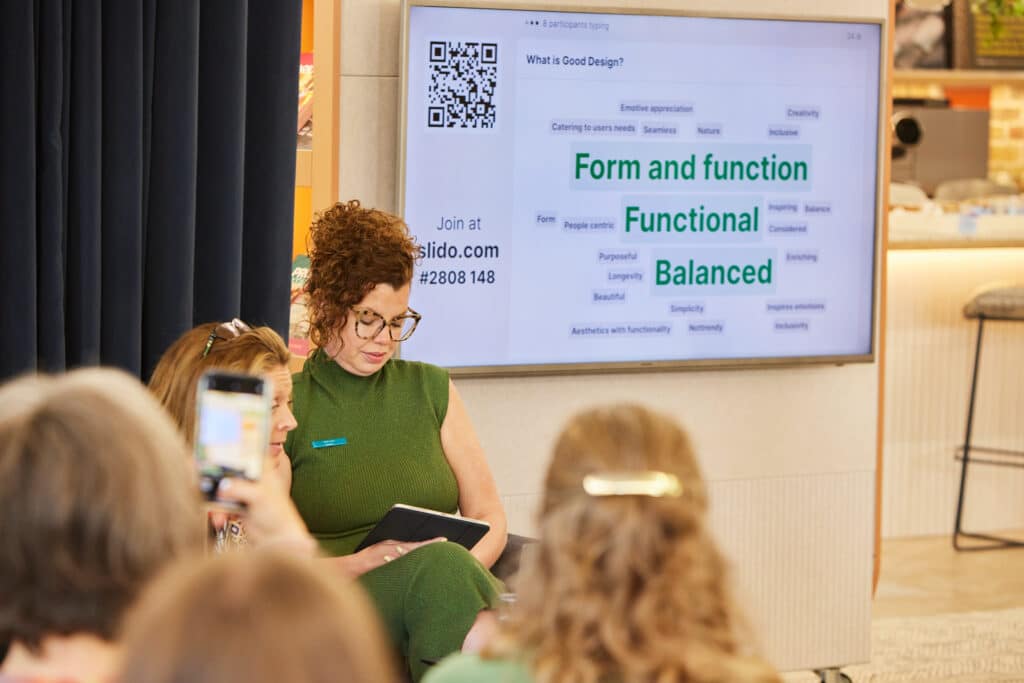At this year’s Clerkenwell Design Week, we hosted an educational session that explored a vital question: Can good design and sustainability truly coexist in today’s commercial spaces? It’s a challenge that many in the architecture and design community face – balancing aesthetics, user experience, and environmental responsibility in equal measure.
During the session, hosted by Becky Gordon, regional sustainability manager UKIME, Laura Light, concept design lead and Sarah Jarvis, concept designer, we shared ideas on what it means to design not only for humans, but for life as a whole. The team came together to lead a thoughtful discussion on how purpose-driven design can meet the demands of an increasingly climate-conscious sector.
From neurodiversity and material circularity to carbon impact and ethical manufacturing – every aspect of design came under scrutiny. Here are some of our takeaways.
Designing With Nature: A Shift Toward Life-Centred Thinking
The panel highlighted a significant shift in design philosophy: from Human-Centred to Life-Centred Design. Whereas Human-Centred Design focuses on user needs, Life-Centred approaches consider the broader ecosystem – human, environmental and social. It’s not just about form and function but about designing in harmony with nature.
By providing nature with a voice in the design process and asking not only ‘what does this space do?’, designers can make more responsible choices that extend well beyond the design brief.

Sensory Inclusivity: Neurodiversity and the Built Environment
Designing for neurodiversity was another central theme, particularly how we create environments that support different sensory and cognitive needs.
Good design is inclusive design. That means providing choice and flexibility to suit a wide range of sensory thresholds. It also means asking better questions from the get-go and involving the right stakeholders early in the design process. From acoustic zoning to flooring solutions that support sensory comfort like varied textures, modular layouts, and softer transitions, behavioural design strategies can help people regulate their working environment and feel more comfortable in their work surroundings.
Sustainability in Practice: Materials, Manufacturing, and Meaningful Change
Sustainability is no longer just a box to check during the specification process. It’s now a design driver in its own right.
At Interface, our sustainability journey is built around carbon, circularity, and material health. From recycled and bio-based content to Health Product Declarations (HPDs), transparency is key. But the conversation at Clerkenwell Design Week went further – acknowledging that where and how a product is made matters just as much as what goes into it.
Manufacturers have a clear responsibility to consider the ripple effects of production – not just on carbon emissions but on the ecosystem at large. Architects and designers, in turn, have a role to play in holding suppliers accountable and asking for the data needed to make informed, future-proofed decisions.

Perfection Isn’t the Goal – Progress Is
A powerful point raised during the session was that we can’t let perfection stand in the way of progress.
Sustainability isn’t about getting everything right on day one. Rather, it’s about continual improvement. Every action – big or small – contributes to a more sustainable built environment. Whether it’s specifying products that support circularity or simply having more open conversations about environmental impact – progress begins with action.
The Verdict – Can Good Design and Sustainability Coexist?
Absolutely. But only when we start designing with life in mind.
That means embracing complexity, asking harder questions, and remembering that the best design isn’t just beautiful or functional – it’s regenerative. It gives back to people, places, and the planet. And, crucially, it creates spaces where all life can thrive equally.
For more guidance on how to design with a sustainability and a life-centered approach in mind, contact us today.